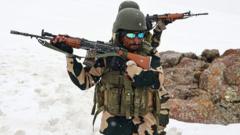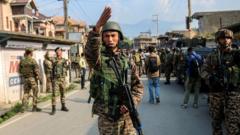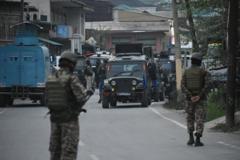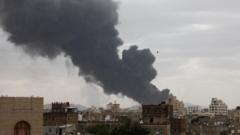The recent escalation in India-Pakistan tensions saw India conducting significant air strikes across Pakistan, raising questions about Pakistan's possible retaliatory actions and the risk of further conflict.
Tensions Surge as India Strikes Pakistan: What's Next?

Tensions Surge as India Strikes Pakistan: What's Next?
Following India's overnight air strikes targeting militant positions in Pakistan, experts speculate on potential Pakistani responses and the implications for regional stability.
Indian air strikes executed against militant targets in Pakistan have intensified fears of a potential military confrontation between the two nuclear-armed neighbors. This latest operation, reportedly lasting only 25 minutes, marked India's demonstration of military resolve, targeting major militant positions linked to groups such as Lashkar-e-Taiba and Jaish-e-Mohammed.
Pakistan responded swiftly to India's claims, asserting that it had downed five Indian fighter jets and suffered casualties from the strikes. Islamabad reported that 26 individuals lost their lives in the air strikes, while India's military declared civilian casualties on its side due to retaliatory Pakistani shelling.
This round of military engagement has renewed conversations around the potential for escalating conflict. Historical precedents from 2016 and 2019 saw surges of violence following significant attacks, with experts emphasizing the possibility of retaliatory actions from Pakistan. Analysts project that Pakistan's military may feel compelled to respond in order to uphold its deterrence credibility.
Further discourse surrounds the potential for this crisis to spiral beyond surgical strikes into broad military conflict, echoing fears of a limited conventional war. Amidst calls for restraint and diplomacy, experts highlighted that Pakistan's political environment—a fractious society primed for reaction—could easily change, especially if nationalist sentiments rise in response to India's military actions.
While many experts believe a return to conflict is plausible, some still hold out hope that diplomatic channels could avert a deeper crisis. Historical examples indicate that despite heightened tensions, opportunities for dialogue have emerged and could play a crucial role, as seen previously when diplomatic engagement successfully led to de-escalation after earlier military encounters.
In this precarious scenario, the balance between aggression and restraint remains vital as both nations navigate the complex terrain of national security and regional stability. With the stakes higher than ever, the international community watches closely, mindful of the fragile peace that could tip into broader hostilities.
Pakistan responded swiftly to India's claims, asserting that it had downed five Indian fighter jets and suffered casualties from the strikes. Islamabad reported that 26 individuals lost their lives in the air strikes, while India's military declared civilian casualties on its side due to retaliatory Pakistani shelling.
This round of military engagement has renewed conversations around the potential for escalating conflict. Historical precedents from 2016 and 2019 saw surges of violence following significant attacks, with experts emphasizing the possibility of retaliatory actions from Pakistan. Analysts project that Pakistan's military may feel compelled to respond in order to uphold its deterrence credibility.
Further discourse surrounds the potential for this crisis to spiral beyond surgical strikes into broad military conflict, echoing fears of a limited conventional war. Amidst calls for restraint and diplomacy, experts highlighted that Pakistan's political environment—a fractious society primed for reaction—could easily change, especially if nationalist sentiments rise in response to India's military actions.
While many experts believe a return to conflict is plausible, some still hold out hope that diplomatic channels could avert a deeper crisis. Historical examples indicate that despite heightened tensions, opportunities for dialogue have emerged and could play a crucial role, as seen previously when diplomatic engagement successfully led to de-escalation after earlier military encounters.
In this precarious scenario, the balance between aggression and restraint remains vital as both nations navigate the complex terrain of national security and regional stability. With the stakes higher than ever, the international community watches closely, mindful of the fragile peace that could tip into broader hostilities.





















